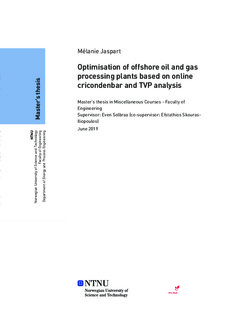| dc.description.abstract | The focus of this work is on an oil and gas offshore plant where the extracted natural gas is processed to deliver on one hand the rich gas, and on the other hand the oil.
Such as plant is simulated thanks to the UniSim software. It includes different steps.
The first one is the transport of natural gas from the well to the inlet of the offshore platform considering pressure drop and heat transfer. At the inlet, liquid and gas are separated.
Then, the condensate stabilization unit which removes the lightest hydrocarbons from the liquid is modelled to meet an oil true vapour pressure (TVP) below 0.965 bar. This step is done by the cascade flash separation process. The TVP specification ensure a safe storage of the oil.
Vapour from this process are sent to the gas recompression train and mixed with the gas coming from the inlet separation.
Finally, the gas processing part consists of controlling the gas cricondenbar by cooling and separation processes so that it is below 110 bar. It enables to ensure to have a single phase for the rich gas transport.
This model is referred as the base case model.
Oil TVP specification is used to optimise the plant. Indeed, this work shows that the rich gas cricondenbar is never a problem, its value is always below the specification. Hence, it is not used to optimise the plant. Three distinct optimisations are done in this work.
The first one consists of maximizing the production of gas. In order to do so, more vaporization is required in the condensate stabilization unit. Hence, the pressure levels are reduced, and the condensate is heated at a higher temperature than in the base case model. Another important parameter is the choice of temperature in the gas processing part. A high temperature enables to generates more vapour. The optimized model enables to increase by 4 % the rich gas production.
The second optimisation is the increase of the production of oil. However, due the relatively high TVP in the base case model, it is not possible to increase the oil production without having a TVP off-spec. It means that the base case model is also the optimal model for oil production maximisation.
Finally, reducing the energy consumption of the offshore plant is the third optimisation done in this work. By modifying the conditions of pressure and temperature along the process the total energy consumption is reduced by 50 %. The most important parameter is the choice of temperature at which the condensate is heated.
In the context of energy consumption reduction, heat integration is achieved. It consists of using the energy released by the different fluids which need to be cooled in the process to heat the condensate in the condensate stabilization unit. Results show that the heat integration has a bigger impact on the reduction of the energy consumption in the base case model than in the model which optimises the energy demand of the plant. It is due to the fact that the energy distribution is different in the two models: thermal energy (heater energy consumption) represents half of the total energy demand of the plant in the base case model whereas it represents only 4 % in the optimized model.
Finally, different liquid recirculation loops are present in the process. This work shows that changing the location where these liquids are sent does not reduce more the energy consumption of the plant than the previous optimized model.
Additional studies show that the composition of the extracted natural gas is relevant for the optimisations. Indeed, process parameters must be changed to meet the rich gas and the oil specifications. Moreover, in some cases, cricondenbar specification is relevant to optimise the offshore plant. This work suggests to first change the parameters that control the most the cricondenbar (the temperature levels in the gas processing part) and then modify the parameters that controls the oil TVP (the heater temperature and the last level of pressure in the condensate stabilization unit).
Since cricondenbar can be off-spec in some cases, PhaseOpt technology, which is an online tool to measure the cricondenbar directly on the field, can be used. | |
